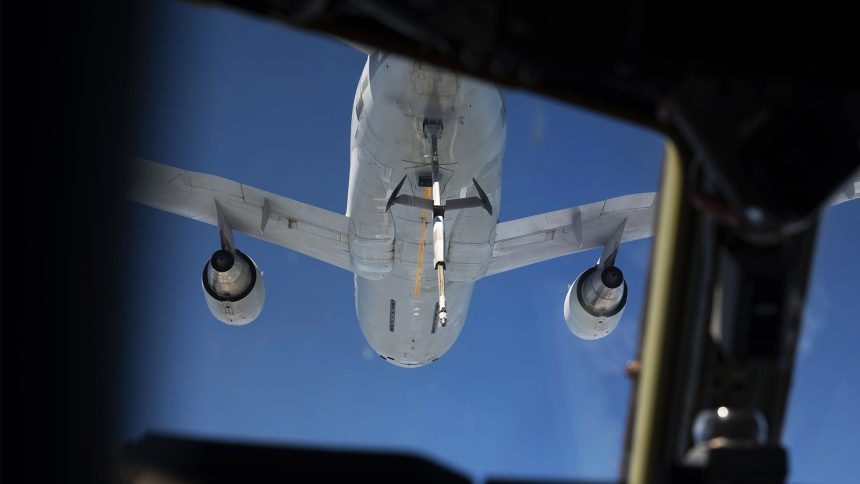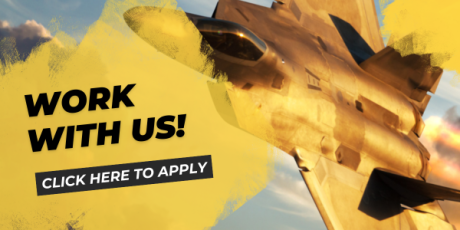On Apr. 10, 2025, a C-17 from Joint Base Lewis-McChord became the first in the U.S. Air Force Air Mobility Command to take fuel from a commercially contracted KDC-10B.
Omega Air Refueling, based in San Antonio, Texas, has operated its own fleet of aerial refueling aircraft since 1999. The company initially operated specially converted Boeing 707 aircraft, but in recent years has expanded the fleet to include KDC-10-30 tankers formerly operated by the Royal Netherlands Air Force and former Japan Airlines KDC-10-40s. The active fleet currently comprises two KC-707s, one KDC-10-30, and one KDC-10-40.
Of these active tankers, the KDC-10-30, N264DE, is unique in being equipped with a flying boom refueling mechanism. This allows it, unlike Omega’s other aircraft, to refuel the majority of aircraft in the U.S. Air Force’s fleet.
N264DE has already completed refueling sorties with a number of U.S. Air Force platforms, including the B-52 Stratofortress, MC-130J Hercules, and F-16 Fighting Falcon. Until now, however, a sortie had not been completed with one of the Air Force’s 222 Boeing C-17 Globemaster III strategic airlifters.

Due to ongoing operations across the world, the U.S. Air Force’s own refueling tanker fleet maintains a high operational tempo and is not always able to support the plethora of other units that require training on air-to-air refueling in addition to its own requirements.
“The 62d AW [62nd Airlift Wing] has limited access to air refueling training, which can impact the currency of our pilots,” explains Major Ryan Vigil, director of wing training with the 62nd Operations Support Squadron. “The training is very similar to what we experience with the KC-10 and KC-46,” he continues. “Omega is driven by operational performance, providing a level of consistency not always achievable with military tankers engaged in diverse mission sets.”
Although the sight of a C-17 refueling from a DC-10 based refueling aircraft will be a familiar one – the KC-10 itself having only recently retired from the U.S. Air Force – behind the scenes on Omega’s KDC-10B lies a very different refueling technology. Rather than having a physical boom operator’s station at the rear of the aircraft the boom is flown from a Remote Aerial Refueling Operator station towards the front. Using an advanced optical sensor system, the boom can be safely steered into the receiving aircraft’s fuel receptacle under the same procedures as the older method.
Remote Aerial Refueling Operator stations are now common on refueling tanker designs, being used on the Airbus A330 MRTT as well as the Boeing KC-767 and KC-46 Pegasus. However, this is the first time such a technology has been installed on a DC-10 refueling aircraft. The Israeli Air Force has also installed this type of system on its fleet of KC-707 Re’em tankers.

Pete Vanagas, Director of U.S. Air Force Business Development for Omega Air Refueling, says the company is proud to have been able to support this training mission: “This mission was significant because it marked the first instance of contracted air refueling of an Air Mobility Command aircraft. Our team provides air refueling to the Department of Defense whenever and wherever needed. We hope to support the C-17A again in the future and build a long-lasting partnership with the 62d Airlift Wing and Air Mobility Command.”
Commercial Air Refueling
Though relatively new for the U.S. Air Force, the U.S. Navy and Marine Corps have contracted the use of Omega Air Refueling aircraft since 2001. As most of their aircraft are refueled using the hose and drogue method, the lack of a refueling boom on Omega’s KC-707s was not a concern. Omega has operated KC-707s both with wing-mounted hose and drogue refueling devices, as well as with aircraft adapted with hose and drogue assemblies within the rear fuselage.
Omega extensively supports training sorties in the U.S. and also routinely provides refueling for aircraft positioning overseas for exercises. Allied air forces, such as the Royal Air Force and Royal Australian Air Force, have also contracted Omega for their own sorties.

Competition has arisen in recent years with Metrea and its sizable fleet of ex Republic of Singapore Air Force and French Air Force KC-135s. Metrea snagged the title of becoming the first commercial provider to refuel U.S. Air Force aircraft when one of these KC-135s delivered approximately 90,000 lbs of fuel to an E-3 Sentry and RC-135 Rivet Joint during Exercise Resolute Hunter in 2023. This milestone occurred only 3 months after the company refueled a P-8A Poseidon belonging to long-term Omega customer, the U.S. Navy. Notably, unlike most U.S. Navy aircraft, the P-8 uses the boom refueling system.
Metra kc-135 coming into land with some nice clouds in the background pic.twitter.com/HxDrF1m4sD
— wavy (@wavy_zyro) November 26, 2023
In March of this year, the Indian Air Force announced that it had contracted Metrea to provide one KC-135 to support pilot training. The contract includes the flight crew and all maintenance, and is expected to commence within six months of the announcement. This came as the nation explores its options to mitigate the low serviceability rates of its Ilyushin Il-78 Midas tankers.









